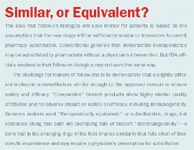Washington Report: Pathways for Proteins
Pharmaceutical Executive
The push is on to establish an approval pathway for generic versions of biotech therapies. The Hatch-Waxman Act of 1984 established a process whereby generic-drug manufacturers could obtain approval for a product based on the innovator company's data. But Hatch-Waxman doesn't apply to biologics regulated by the Public Health Service Act, and generics makers-as well as some Big Pharma companies and small biotech firms-want Congress to give the Food and Drug Administration authority to set up a similar process for these products as well.
The push is on to establish an approval pathway for generic versions of biotech therapies. The Hatch-Waxman Act of 1984 established a process whereby generic-drug manufacturers could obtain approval for a product based on the innovator company's data. But Hatch-Waxman doesn't apply to biologics regulated by the Public Health Service Act, and generics makers—as well as some Big Pharma companies and small biotech firms—want Congress to give the Food and Drug Administration authority to set up a similar process for these products as well.

Jill Wechsler
As momentum builds for legalizing follow-on proteins (FDA's preferred term), pharma wants to keep the issue from blocking speedy reauthorization of the Prescription Drug User Fee program. Billy Tauzin, president of PhRMA (Pharmaceutical Research and Manufacturers of America), said at a recent press briefing that "there will be and there should be" follow-ons, but that the legislation should be "done correctly" and not become "a political football."
Cutting Costs
Payers, pharmacy benefit managers (PBMs), and patient advocates see follow-ons as a way to ratchet down the cost of increasingly expensive therapies. Life-saving drugs are not worth much, they argue, if patients can't afford them. Express Scripts, a PBM, unveiled a report in February projecting savings of some $70 billion over 10 years from biogenerics. Another study put the savings at $14 billion for Medicare alone.
On the other hand, consulting firm Avalere Health estimates savings of only $3.6 billion over 10 years. The firm's analysts say it will take years for follow-ons to be developed and approved, and that these products will cost more to test and produce than conventional drugs. Moreover, if follow-ons are not interchangeable with innovator products, physicians will be slow to prescribe them.

Similar, or Equivalent?
Well-known health economist Henry Grabowski of Duke University explained at a hearing before the House Oversight and Government Reform Committee in March that the fairly high cost of developing follow-ons will limit market competition, resulting in discounts of 10 to 25 percent—not the 60-percent price cuts seen in the highly competitive generic-drug market. But payers say that prices even 10 percent lower will save millions on products that in some cases cost more than $100,000. The United States spends more than $3 billion a year on insulin, and state Medicaid agencies are scratching for any savings they can find.
Seeking Exclusivity
Given the political pressures to legalize follow-ons, brand-name firms are focusing on patent protection. The Hatch-Waxman Act provides five years of exclusivity before generics can challenge a new drug's patent. In Europe, drugs and biologics essentially are protected for 11 years—and that looks good to US innovators, especially small biotech companies. The high cost of developing new biologics—which the Tufts Center puts at $1.25 billion fully capitalized—and of manufacturing them warrants stronger patent protection, the industry claims.
The lead biogeneric bill, sponsored by Rep. Henry Waxman (D-CA) and backed by Sen. Hillary Clinton (D-NY), doesn't address exclusivity. But generic-industry leaders appear willing to negotiate the issue in order to move legislation forward.
Stress on Science
The ultimate cost of follow-ons will depend largely on how much pre-clinical and clinical testing sponsors have to conduct to gain FDA approval. Innovators insist that some clinical testing is necessary and that even then follow-ons won't be equivalent to brands. Everyone says that science should determine the scope of follow-on testing, but there's disagreement over where the science stands. The key questions:
Can analytical techniques ensure follow-on comparability and safety? "Our ability to make and characterize protein products and other complex biologics has progressed rapidly in the last few decades," said Ajaz Hussain, vice president of Sandoz and former FDA official, in testimony before the Senate health committee in early March. Small biotechs are developing new scientific approaches for developing biogenerics, such as a protein-characterization platform described by Insmed president Geoffrey Allan at the House hearing. Seattle-based Cell Therapeutics recently announced it is developing a genetic polymer technology that would speed follow-on development.
Can comparability protocols support follow-ons? FDA allows innovators to use mass spectroscopy and other technologies to demonstrate that their products are unaltered after a change in a manufacturing process or a move to a new plant. At the House hearing, FDA Deputy Commissioner Janet Woodcock noted that if the agency is to predict clinical comparability of a follow-on, it needs full information on the structure of a protein and the product's mode of action. FDA wants to encourage companies to continuously improve manufacturing processes; as a result, it tries to limit how much data it requires to document comparability following manufacturing changes. But, Woodcock explained, a new manufacturer would not have all the information about the innovator's intermediate manufacturing steps and would bear the burden of demonstrating that the new therapy works exactly as the original product.
Are clinical trials necessary to bring a follow-on to market? Innovators say always; generics makers, seldom; and FDA, sometimes (based on the complexity of the product and its clinical use and experience). "Some degree of clinical assessment of a new product's immunogenic potential will ordinarily be needed," said Woodcock. But it's unclear if this means small pharmacokinetic studies or large randomized clinical trials. FDA required considerable additional clinical testing for Sandoz's Omnitrope follow-on, but not as much as for the innovator.
Innovators say that seemingly minor changes in a drug's formulation can increase immunogenicity and harm patients. At the Senate hearing, former FDA official Jay Siegel, now at Johnson & Johnson, described how a change in stabilizer for Eprex (erythropoietin) increased immunogenicity and led to serious red-cell aplasia in patients.
But some experts argue that clinical trials are not always the best way to assess structural changes to products. While FDA may ask for additional PK studies to evaluate differences following manufacturing changes, the agency seldom requires large outcomes studies. And if trials are not needed, Woodcock added, it may be unethical to require them.
Can follow-ons be equivalent? Documenting comparability is quite challenging, said J&J's Siegel, but "ensuring interchangeability is essentially impossible." Only extensive comparison studies can rule out clinically significant differences, he said, noting that even with extensive testing, Omnitrope did not get a therapeutically equivalent rating from FDA. To demonstrate substitutability, Woodcock says that the follow-on sponsor may need studies showing that repeated switches between the innovator and the follow-on has no negative effects. The European Union talks only of "biosimilars," emphasizing that these products are not generic copies.
Let FDA Decide
Woodcock emphasized the need for a flexible policy for regulating the wide range of complex biologics. As with EU regulators, FDA envisions a case-by-case approach to testing and evaluating comparability of follow-ons.
To assist manufacturers, the agency is preparing long-awaited guidance to clarify what data it recommends for developing follow-on proteins governed by the Food, Drug, and Cosmetic Act, such as human growth hormone and insulin. Additional guidances will address technical issues such as immunogenicity and physical-characterization methods. Establishing an approval pathway for this limited list of biotech therapies would support subsequent policies for approving a broader range of follow-ons.
Evaluation of such products will be complex and time-consuming, but Woodcock says FDA has the expertise to make the hard decisions that will arise. Overall, agency officials anticipate a gradual evolution toward follow-ons. While FDA now has the tools to assess comparability of small peptides, Woodcock explained, it may take a decade to develop similarly precise methods for larger molecules.
Patents will expire in the next few years on important biotech therapies, so follow-on advocates are eager to offer them in more affordable versions. Generics makers also appear willing to pay user fees for FDA to process the applications, which could provide a rationale for including Waxman's biogeneric bill in a PDUFA package.
Jill Wechsler is Pharm Exec's Washington correspondent. She can be reached at jwechsler@advanstar.com

FDA Outlines Updated Requirement for Placebo-Controlled Trials in Vaccine Research
May 21st 2025In an article recently published by The New England Journal of Medicine, FDA higher-ups Vinay Prasad, MD, MPH; and Martin A. Makary, MD, MPH, wrote that any new COVID-19 vaccine must now be evaluated in placebo-controlled studies.
Addressing Disparities in Psoriasis Trials: Takeda's Strategies for Inclusivity in Clinical Research
April 14th 2025LaShell Robinson, Head of Global Feasibility and Trial Equity at Takeda, speaks about the company's strategies to engage patients in underrepresented populations in its phase III psoriasis trials.
Beyond the Prescription: Pharma's Role in Digital Health Conversations
April 1st 2025Join us for an insightful conversation with Jennifer Harakal, Head of Regulatory Affairs at Canopy Life Sciences, as we unpack the evolving intersection of social media and healthcare decisions. Discover how pharmaceutical companies can navigate regulatory challenges while meaningfully engaging with consumers in digital spaces. Jennifer shares expert strategies for responsible marketing, working with influencers, and creating educational content that bridges the gap between patients and healthcare providers. A must-listen for pharma marketers looking to build trust and compliance in today's social media landscape.

.png&w=3840&q=75)

.png&w=3840&q=75)



.png&w=3840&q=75)



.png&w=3840&q=75)






















